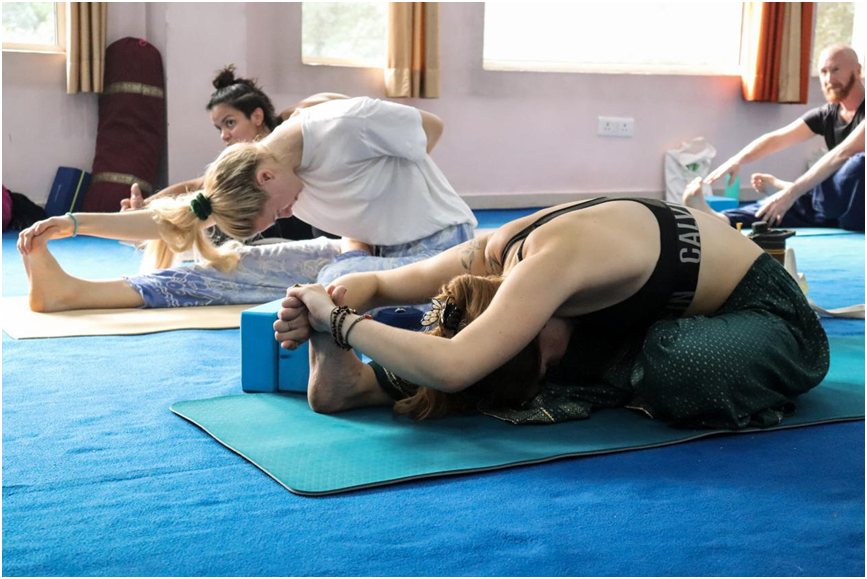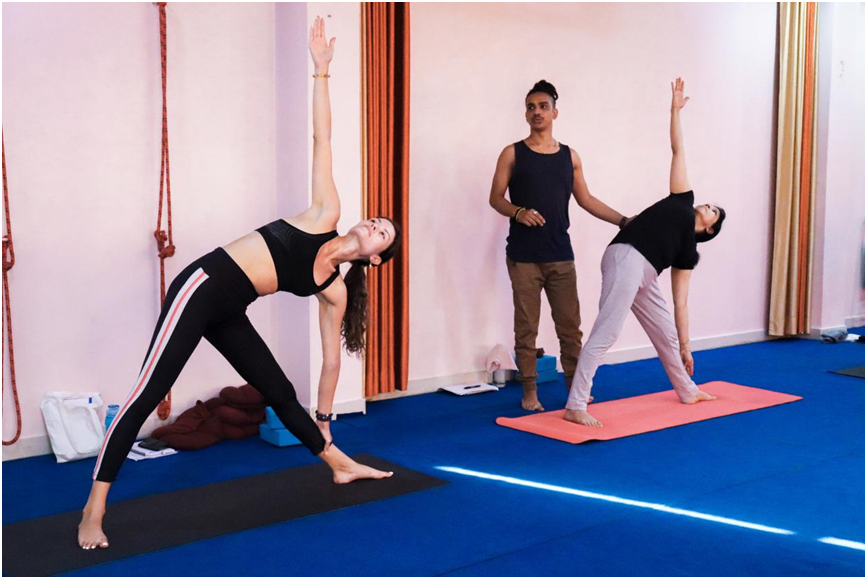An Ashtanga Yoga Teacher Training Course (TTC) is an intensive program designed to deepen your understanding of Ashtanga Yoga and prepare you to teach it professionally. Rooted in the traditional practice established by Sri K. Pattabhi Jois, the course typically focuses on the Ashtanga Vinyasa Yoga Primary Series, along with its philosophical and practical aspects.
Rishikesh, often referred to as the “Yoga Capital of the World,” is a hub for yoga enthusiasts seeking authentic teacher training programs. A 200hour Ashtanga Yoga Teacher Training Course in Rishikesh is designed for individuals looking to deepen their yoga practice, gain teaching skills, and explore the traditional roots of Ashtanga Yoga.

Key Highlights of a 200-Hour Ashtanga Yoga TTC
1. Primary Series Mastery:
Learn and practice the Ashtanga Vinyasa Yoga Primary Series (Yoga Chikitsa), which focuses on alignment, flexibility, and strength.
2. Pranayama Techniques:
Study traditional breathing practices to enhance energy flow and balance.
3. Meditation Practices:
Develop mental clarity and mindfulness through guided meditation sessions.
4. Yoga Philosophy:
Explore ancient yogic texts like the Yoga Sutras of Patanjali to understand the philosophy behind yoga.
5. Anatomy and Physiology:
Learn the biomechanics of the human body to practice and teach safely.
6. Teaching Methodology:
Gain confidence in conducting yoga classes, understanding class structures, and adjusting students effectively.
7. Cleansing Practices (Kriyas):
Study yogic cleansing techniques for detoxification.
Choosing the right yoga school for your 200-hour Ashtanga Yoga Teacher Training Course (TTC) in Rishikesh is essential to ensure a fulfilling and transformative experience. Here’s a step-by-step guide to help you make the best decision:
1. Accreditation
- Yoga Alliance Certification: Ensure the program is certified by Yoga Alliance or a similar recognized body. This ensures international recognition and quality standards.
- Curriculum Standards: Look for a detailed curriculum covering Ashtanga Vinyasa Primary Series, pranayama, meditation, philosophy, anatomy, and teaching methodology.
2. Teaching Faculty
- Experienced Instructors: Check if the teachers have years of experience and a deep understanding of Ashtanga Yoga. Look for profiles on the school’s website or testimonials from past students.
- Lineage and Tradition: A school rooted in the traditional practice of Ashtanga Vinyasa is ideal for authenticity.
3. Course Structure
- Practice and Theory Balance: Ensure the course includes a balance between asana practice, philosophy, pranayama, and teaching techniques.
- Student Support: Check if the program includes personalized feedback, hands-on adjustments, and practice teaching.
4. Class Size
- Smaller Batches: Schools with smaller batch sizes (10–20 students) often provide more individual attention and better guidance.
5. Accommodation and Food
- On-Campus Facilities: Many schools in Rishikesh offer clean, comfortable accommodation as part of the package.
- Food Quality: Meals are typically vegetarian and sattvic (yogic diet). Ensure they meet your dietary preferences.
6. Location and Ambience
- Peaceful Setting: Schools near the Ganges or in quieter parts of Rishikesh, such as Tapovan or Ram Jhula, offer serene environments for learning.
- Access to Nature: A location surrounded by nature can enhance your overall experience.
7. Reviews and Testimonials
- Student Feedback: Read online reviews on platforms like Google, Yoga Alliance, or social media to gauge past students’ experiences.
- Alumni Network: A strong alumni community can indicate the school’s reputation.
8. Cost and Value
- Transparent Pricing: Ensure the fee covers all essentials, including tuition, accommodation, food, and study materials.
- Value for Money: A higher price doesn’t always guarantee quality, so focus on reviews and course content.
9. Additional Offerings
- Workshops and Activities: Some schools offer additional classes on Ayurveda, chanting, or yoga therapy.
- Post-Course Support: Look for schools offering guidance even after you complete the course.
10. Trial Class or Consultation
- Pre-Visit Interaction: Some schools allow you to join a trial class or consult with instructors before enrolling. This can give you an idea of their teaching approach.
Top Schools to Consider
- Yoga Vidya Mandiram– Renowned for traditional Ashtanga practices. This Yoga School stands a bridge between pure and traditional form and the contemporary format of yoga and meditation learnings.
- Sri Yoga Ashram – Budget-friendly with quality training.
- Arohan Yoga – Known for multi-style training with an emphasis on Ashtanga.
Checklist Before Enrolling
- Accreditation proof and certification details.
- Detailed syllabus and course schedule.
- Accommodation and meal options.
- Refund or cancellation policy.
- Student testimonials and reviews.
Conclusion
Choosing the right yoga school in Rishikesh for your 200-hour Ashtanga Yoga TTC is about aligning your goals with the school’s philosophy, curriculum, and environment. Prioritize accredited schools with experienced teachers, a comprehensive curriculum, and positive reviews. A serene location, comfortable facilities, and personalized attention will further enhance your experience.
By taking the time to research and reflect, you’ll find a school that not only trains you to teach but also transforms your practice and deepens your connection to yoga.


